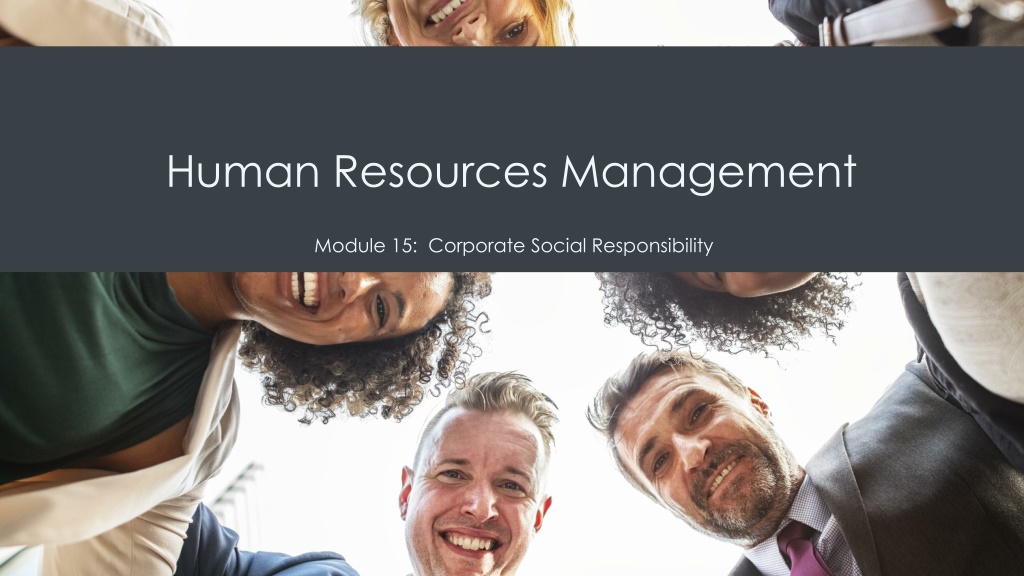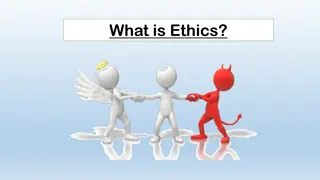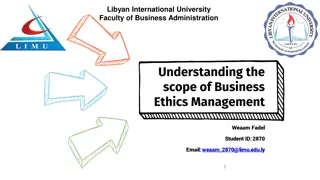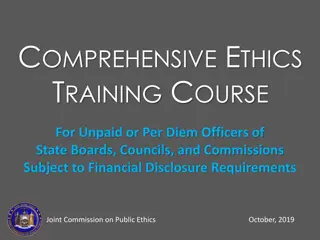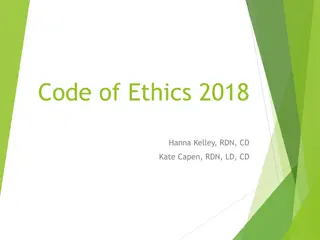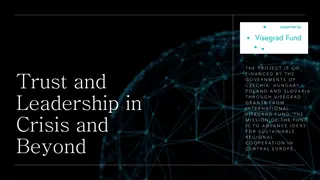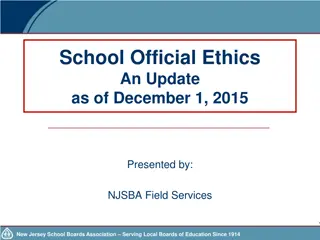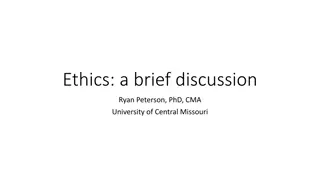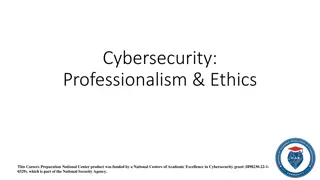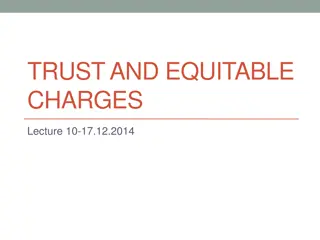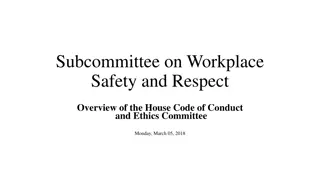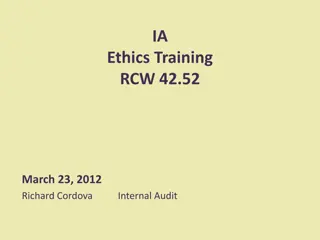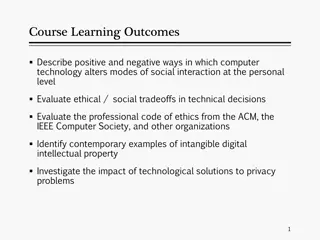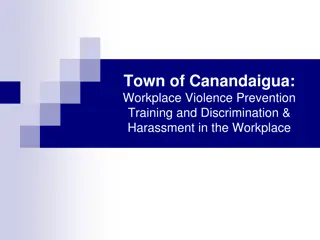Understanding Ethics and Building Trust in the Workplace
Ethics play a crucial role in modern business environments, influencing decision-making and conduct. They are shaped by culture, philosophy, and religion. Perception and priority impact ethical positions, with workplace issues like climate change and equitable pay being polarizing. Organizations can create ethical guidelines and codes of ethics to promote a trustworthy environment. HR professionals are key in fostering trust through competence, integrity, and care. Building trust involves behaviors like demonstrating competence, admitting mistakes, and meeting commitments. A practical class activity involves crafting a corporate code of ethics.
Download Presentation

Please find below an Image/Link to download the presentation.
The content on the website is provided AS IS for your information and personal use only. It may not be sold, licensed, or shared on other websites without obtaining consent from the author. Download presentation by click this link. If you encounter any issues during the download, it is possible that the publisher has removed the file from their server.
E N D
Presentation Transcript
Human Resources Management Module 15: Corporate Social Responsibility
Module Learning Outcomes Discuss the importance and legal ramifications of ethics, social responsibility and sustainability in the modern business environment. 15.1: Explain the concept and business relevance of ethics 15.2: Explain the concept and business relevance of sustainability 15.3: Explain the concept and business relevance of social responsibility
Learning Outcomes: Ethics 15.1: Explain the concept and business relevance of ethics 15.1.1: Discuss ethics in the workplace 15.1.2: Describe the human resource implications of ethics 15.1.3: Discuss how to create an ethical workplace
What are ethics? A system of moral principles that provide a framework for decision-making and conduct, variously derived from culture, philosophy and religion.
Ethics are affected by perception and priority Perception and priority can polarize and impact ethical position Polarizing workplace issues can include: Climate change Equitable pay Equal rights Medically provided contraception
Ethical guidelines are a good place to start Organizations can develop a code of ethics to which members/employees agree to adhere.
HR professionals help build trust for organizations and employees Competence Competence Integrity Integrity TRUST TRUST Care Care Dependability Dependability
Behaviors that build trust Demonstrating role competence Admitting mistakes Accepting feedback Open to influence Meeting commitments
Class Activity: Your Corporate Code of Ethics A culture of ethics is the right thing for any business, large or small. Pretend you re the owner of a small landscaping business with about fifty employees. Gather in a group of four or five and, as a group, complete the following: A code of ethics for your company (feel free to use other companies codes as examples for your own, many publish them online!) A method by which you implement this new code of ethics.
Creating an ethical culture Human resources professionals can impact culture via Hiring Training Evaluating Ethical culture checklist Watch for signs of danger Avoidance Fear of retaliation Conflicting goals Rationalization Lowered thresholds Euphemisms
Practice Question 1 Which of the following is true about ethics? A. It is considered a personal rather than business or workplace issue. B. It is a generally accepted agreement on what workplace behavior is right and wrong. C. It impacts consumer, employment, and investment choices and increases business performance. D. It is only relevant in the workplace if one has pledged to abide by a professional code of conduct.
Practice Question 2 Nasim wants to create an ethical culture in her workplace. Which of the following actions would best help her accomplish this? A. disregarding unethical behavior. B. clarifying what ethical means in the organization. C. penalizing those who report unethical behavior. D. establishing conflicting or unrealistic goals.
Learning Outcomes: Sustainability 15.2: Explain the concept and business relevance of sustainability 15.2.1: Define sustainability and describe its benefits 15.2.2: Discuss the role of human resource management in advancing sustainability
Understanding Sustainability Development that meets the needs of the present without compromising the ability of future generations to meet their own needs.
Benefits of sustainability More strategic management Reduce energy, waste and costs Competitive differentiation Minimize the impact of future regulations Innovation Open new markets Attract/retain employees Improved image Reduce risk Higher quality of life
HR Managers can champion sustainability within their organization Don t Provide training without an associated plan in place Solicit ideas that are never implemented or acted upon Hijack language that might evoke mixed responses, like climate change and environmentalist Do Introduce the topic to senior executives Align HR systems to embed sustainability into the culture Model sustainable practices Measure the impact
64% consider a companys social and environmental commitments when deciding where to work 88% say their job is more fulfilling when they are provided opportunities to make a positive impact on social and environmental issues and 83% would be more loyal to a company that helps them contribute to social and environmental issues. Millennials value sustainability
Practice Question 3 Which of the following best articulates the benefits of sustainability? A. Sustainability performance is highly correlated with financial performance and can yield several strategic and operational benefits. B. Sustainability initiatives may prevent the passage of more stringent regulations. C. Sustainability initiatives may result in energy and waste-related cost reductions.
Learning Outcomes: Corporate Social Responsibility 15.3: Explain the concept and business relevance of corporate social responsibility 15.3.1: Discuss corporate social responsibility 15.3.2: Summarize the business relevance of corporate social responsibility
Why CSR? 63% of Americans are hopeful businesses will take the lead to drive social and environmental change moving forward, in the absence of government regulation. 78% want companies to address important social justice issues 87% will purchase a product because a company advocated for an issue they cared about 76% will refuse to purchase a company s products or services upon learning it supported an issue contrary to their beliefs
Practice Question 4 Corporate social responsibility (CSR) is best summarized as: A. A corporation s responsibility to its shareholders. B. A corporation s responsibility to its stakeholders. C. A corporation s responsibility to be profitable. D. A corporation s responsibility to comply with relevant laws.
Quick Review HR professionals can contribute to the construction of an ethical culture in their workplace by Building trust within the organization Hiring, training and evaluating with an ethical focus Sustainability is a profitable and growing priority for corporations Consumers, employees and stakeholders prioritize businesses who advocate corporate social responsibility
